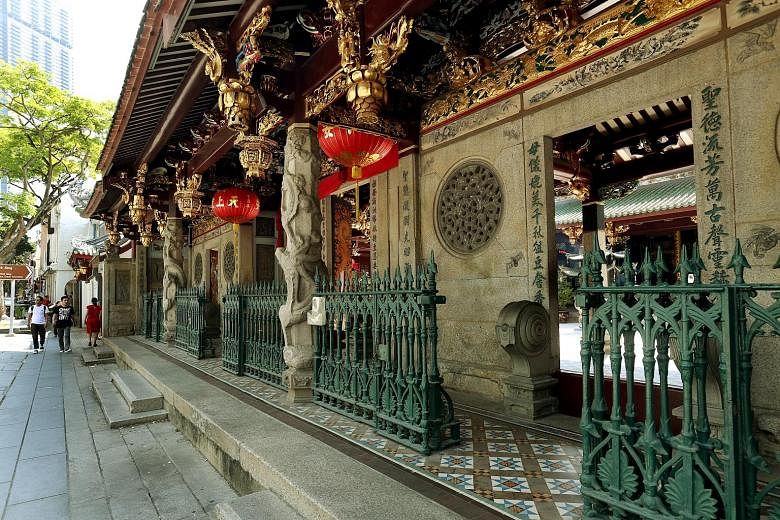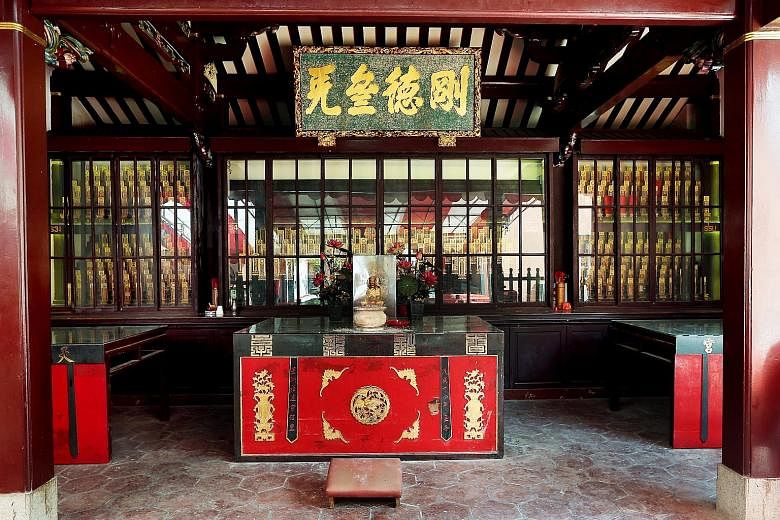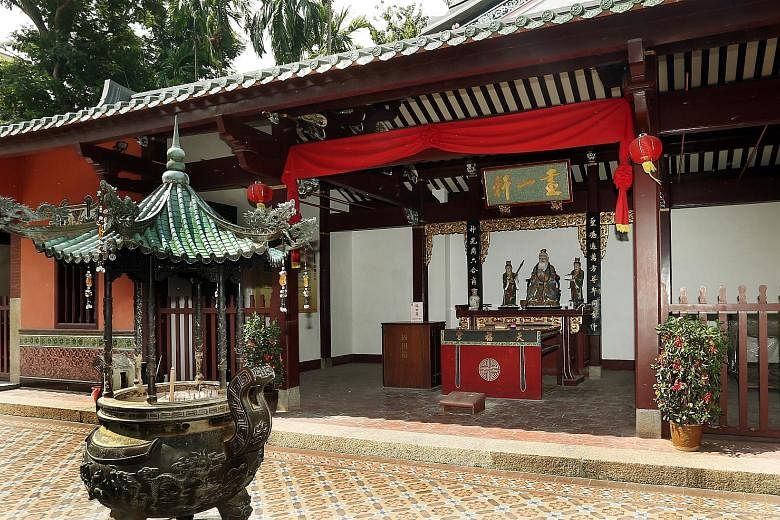It may be more than 170 years old but Chinese temple Thian Hock Keng still stands tall in Telok Ayer Street, a witness to the hardships of the early Chinese immigrants.
It is dedicated to the goddess of the sea Mazu, also known as Ma Cho Po or Tian Hou, the patron deity of weary seafarers. The name Thian Hock Keng means "temple of heavenly happiness" in the Hokkien dialect, as its devotees equated the goddess' blessings to celestial prosperity.
In the 1800s, Chinese immigrants who had safely landed on Singapore's shores following a treacherous journey by sea would light joss sticks and present thanksgiving offerings to Mazu. Those returning home would in turn pray for a safe voyage.
A pair of stone lion sculptures flank the main entrance of the temple, guarding it against evil spirits. On the facade of the temple are carved stone windows with engravings of bats in their four corners, representing luck and prosperity.
The roofs of the entrance and main halls are curved and feature upturned "swallow tail" end sweeps. Perched atop each roof are four dancing dragons, a motif of strength and justice, which flank a blazing pearl that symbolises immortality and perfection.
Devotees access the temple through the entrance hall. After crossing the front courtyard, they enter the main hall, where the enshrined main deity Mazu is flanked by Guan Di, the god of war, and Bao Sheng Da Di, the protector of life.
Guan Yin, the Buddhist goddess of mercy, is enshrined in the rear hall. There are other statues housed in the temple's side halls, such as that of the ancient Chinese scholar Confucius.
The present temple was constructed between 1839 and 1842 to replace a humble shrine which was built in 1821.
It cost 30,000 Spanish dollars, a whopping sum at that time, and was funded by owners and sailors of the Chinese junks at the harbour, as well as prosperous Hokkien merchants and community leaders.
One of the notable donors was Mr Tan Tock Seng, an eminent Melaka-born Hokkien merchant and well-known philanthropist. He is perhaps best known today as the person who helped establish a hospital for the poor in 1844, which still bears his name.
The temple also housed the Hokkien Huay Kuan, or the Hokkien association, which was established in 1840 by Chinese philanthropists. The association sought to champion education among the local Chinese, as well as to offer aid and look after newly arrived immigrants from China's Fujian province.
Despite Thian Hock Keng's connection with the Hokkien community, the founders intended the temple to serve all Chinese people, regardless of dialect group.
The original wooden Mazu statue was made in China and brought to Singapore from Fujian province in April 1840.
The event was reported in The Singapore Free Press, Singapore's second English-language newspaper, as a grand procession which extended about 480m long.
In the report, it was also written that the goddess Mazu appeared to be "highly venerated", and that "a very elegant temple, according to Chinese taste, has been built in the town for her reception".
Hanging in the temple's main hall is a horizontal wooden plaque inscribed with four Chinese characters, which read "bo jing nan ming". It was bestowed by Emperor Guangxu of Qing China in 1907, and means "gentle waves on the southern seas", a blessing from the emperor for a safe journey.
It is a symbol of the emperor's favour, and was granted in recognition of aid provided by Singaporean Hokkien merchants to flood-relief efforts in Fujian province in 1905.
Thian Hock Keng, which was gazetted as a national monument by the Singapore Government in 1973, has undergone multiple restoration and repair works through the years. One of the most significant restoration projects took place from 1998 to 2000, and cost close to $4 million.
It was a massive project organised after termites were found to be feeding on the temple's wooden structures. Nearly 70 craftsmen and artisans from Fujian were involved in preserving the temple's facade and physical appearance.
The temple won honourable mention in the 2001 Unesco Asia-Pacific Heritage Awards, attesting to the success of the restoration project.
Today, Thian Hock Keng continues to be visited by devotees and tourists. The temple also offers a place to install ancestral tablets in remembrance of the deceased.
Mr Tan Aik Hock, chairman of the temple management committee, said visitors and worshippers come from "all over the world and all walks of life". Ms Dana Thong, a beautician, visits the temple once or twice a month. The 35-year-old Malaysian who works in Singapore prays for safe passage as she frequently commutes between the two countries.
Another devotee is Mr Alan Ong, a bank officer who works near the temple. The 60-year-old has been visiting the temple for at least 20 years, and prays to the various deities for general peace and well-being.
"I think that (the number of visitors) has increased," he said. "Tourists, definitely a lot, so much more than last time."



